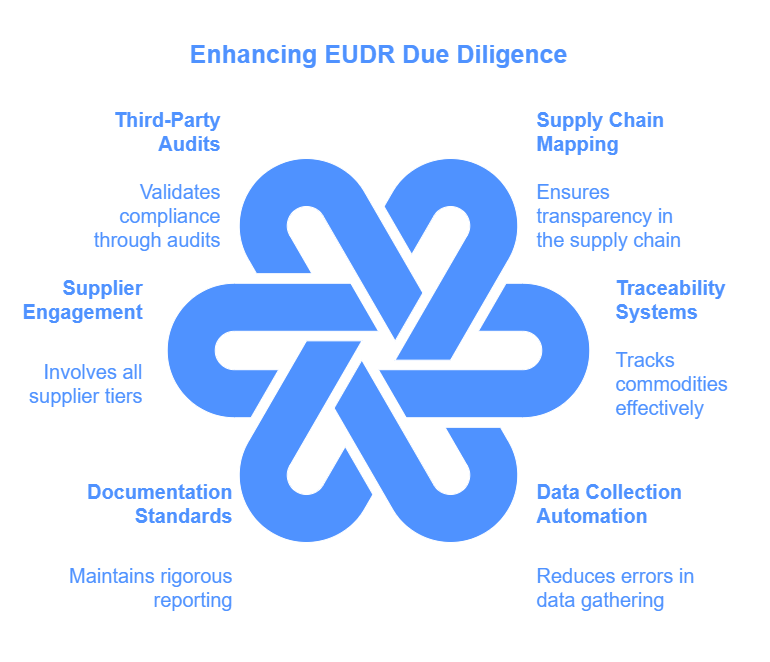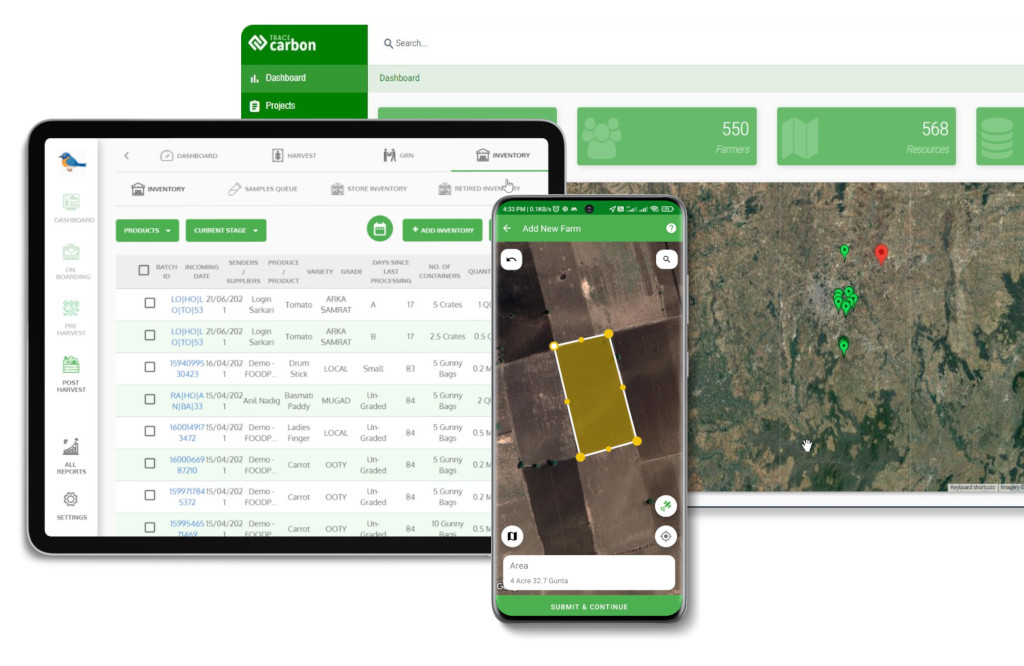Contact: +91 99725 24322 |
Menu
Menu
Quick summary: Learn how to identify and avoid common EUDR due diligence mistakes. Ensure compliance with expert strategies and effective tools.

Did you know? 65% of businesses fail their first EUDR audit due to improper due diligence! If your business exports agricultural commodities like coffee, cocoa, rubber, or timber, avoiding these common EUDR Due Diligence mistakes is critical The EU isn’t just requesting compliance—it’s demanding proof. One missing geolocation record, a vague supplier statement, or an overlooked land-use report can lead to shipment rejections, lost buyers, and legal trouble.
These issues can result in penalties, damage to brand reputation, and delays in achieving regulatory goals. By recognizing these pitfalls early, companies can take proactive measures to avoid costly mistakes and ensure seamless compliance with the regulation. Let’s break them down—and more importantly—show you how to fix them.
Key Takeaways
The European Union Deforestation Regulation (EUDR) is an important piece of legislation aimed at tackling the issue of deforestation linked to trade. Let’s break down what it is, its objectives, and the key due diligence requirements that businesses need to be aware of.
The EUDR was adopted in June 2023 as part of the EU’s broader commitment to environmental sustainability under the European Green Deal. Its main goal is to reduce the EU’s contribution to global deforestation and promote sustainable practices in supply chains. Here are some of its key objectives:
To comply with the EUDR, businesses must undertake specific due diligence activities. Here’s what they need to know:
1. Conduct Risk Assessments: Companies are required to assess the risk of deforestation associated with their supply chains. This means looking into where their products come from and evaluating whether those sources have been involved in deforestation.
2. Due Diligence Statement: Businesses must submit a Due Diligence Statement to EU authorities. This document should outline how they assess and mitigate risks related to deforestation in their operations.
3. Geolocation Data: Companies must provide geolocation data for their products. This means they need to show exactly where their commodities are sourced from, ensuring that they are not linked to deforested areas.
4. Record Keeping: It’s essential for businesses to maintain records of their due diligence activities for at least five years. This documentation will be crucial for demonstrating compliance during inspections or audits.
5. Public Availability: The due diligence statements must be made publicly available. Transparency is key here; consumers and stakeholders should be able to see how companies are addressing deforestation risks.
6. Compliance Timeline: While large businesses must comply by December 30, 2025, small and medium-sized enterprises (SMEs) have until June 30, 2026, giving them additional time to prepare for these requirements.
The EUDR represents a significant step towards ensuring that European markets do not contribute to global deforestation. By implementing robust due diligence practices, businesses can not only comply with these regulations but also contribute positively to environmental sustainability efforts.
Navigating the European Union Deforestation Regulation (EUDR) compliance can be complex, and many businesses face common pitfalls in their due diligence processes. Here are some real-life examples that illustrate these challenges, along with explanations of how they manifest in practice.
You’re a rubber exporter shipping to the EU. You’ve checked your supplier’s certifications, ensured your products meet quality standards, and submitted your due diligence statement. Then—boom—your shipment is rejected at customs because one supplier along the chain lacked geolocation data for their plantations.
This isn’t a hypothetical scenario—it’s happening right now to companies struggling with EUDR compliance.
The EUDR doesn’t just require companies to claim their products are deforestation-free—it demands verifiable proof at every stage of the supply chain. That means knowing exactly where your raw materials come from, tracing supplier contributions, and linking everything with geolocation data.
Here’s where businesses fail:
How to Fix It – Build a Bulletproof Supply Chain Map
The clock is ticking—EUDR enforcement is already underway. If you don’t have full supply chain transparency, you’re at high risk of losing EU buyers. Fix the gaps now before compliance failures cost you millions.
You’ve spent months securing contracts with European buyers. Your products meet sustainability claims, and your supply chain is certified. But then—your shipment gets rejected because your due diligence statement lacks verifiable traceability data.
This isn’t a rare occurrence—businesses across rubber, coffee, palm oil, and timber supply chains are losing millions due to traceability gaps that make them non-compliant with the EU Deforestation Regulation (EUDR).
Traceability Isn’t a Checkbox—It’s the Backbone of Compliance
EUDR compliance isn’t just about collecting supplier documents—it requires real-time, verifiable traceability from farm to export. A missing link in your chain of custody could mean entire shipments are deemed illegal—even if 99% of your supply chain is compliant.
Where Businesses Fail:
How to Fix It – Build a Foolproof Traceability System
EUDR enforcement is already in motion. If your business lacks a robust traceability system, you’re at high risk of losing EU buyers. Don’t wait until a rejected shipment costs you millions.
Imagine spending months securing a contract with an EU buyer, only to lose it because your compliance records were incomplete, outdated, or manually entered with errors.
This is happening right now to businesses across the coffee, palm oil, timber, and rubber industries. As the EU Deforestation Regulation (EUDR) is enforced, companies relying on spreadsheets, emails, and paper logs are struggling to keep up—and paying the price in delayed shipments, financial losses, and lost buyers.
Why Manual Processes Are a Major Compliance Risk
EUDR compliance requires speed, accuracy, and real-time visibility—something paper-based records and spreadsheets simply can’t deliver.
Where Businesses Fail:
How to Fix It – Move to Automated EUDR Compliance
EUDR enforcement is already in effect. If you’re still relying on manual processes, you’re one audit away from non-compliance penalties and losing EU buyers.
Your shipment is stuck at the EU border, flagged for non-compliance because your due diligence statement lacks the necessary details. Your buyer is frustrated, your supply chain is delayed, and your reputation takes a hit—all because of a missing document or an outdated compliance report.
This is the new reality for businesses in rubber, coffee, palm oil, cocoa, timber, and soy as the EU Deforestation Regulation (EUDR) takes full effect. Companies that fail to meet strict documentation and reporting standards are facing rejected shipments, financial penalties, and even bans from EU markets.
Where Businesses Fail
EUDR compliance isn’t just about proving deforestation-free sourcing—it’s about how you document it, store it, and report it.
How to Fix It – Automate EUDR Documentation & Reporting
Don’t risk losing your EU buyers over missing paperwork. If your documentation isn’t airtight, your business is already one rejected shipment away from serious losses.
Most companies assume that if their direct suppliers comply with EUDR, they’re in the clear. Wrong. EUDR doesn’t just stop at your immediate suppliers—it requires compliance throughout your entire supply chain, all the way down to the farm or forest.
Why Multi-Tier Supplier Engagement is a Compliance Nightmare
The Urgency: What Happens if You Ignore This?
How to Fix This: A Multi-Tier Compliance Strategy
These examples illustrate some common pitfalls businesses may encounter while navigating the EUDR due diligence process. By learning from these real-life scenarios—like ensuring comprehensive supply chain mapping, implementing robust traceability systems, avoiding manual processes, meeting documentation standards, and engaging effectively with multi-tier suppliers—companies can better prepare themselves for compliance and contribute positively to sustainability efforts in their supply chains. As the EUDR implementation date approaches, addressing these challenges will be crucial for businesses operating within or trading with the EU market.

Using technology can make a big difference in how businesses map their supply chains. For example, TraceX offers a EUDR Compliance platform that integrates with existing systems to help companies track their products from the source to the final product. By using such technology, businesses can easily identify where their materials come from and ensure they are sourced sustainably. This not only simplifies compliance but also saves time and reduces errors compared to manual tracking methods.
Blockchain technology is a powerful tool for ensuring traceability in supply chains. It creates an immutable record of every transaction, making it easy to verify the origins of raw materials. This technology helps businesses build trust with consumers and regulators by ensuring that all claims about sustainability are backed by verifiable data.
Regular audits and training sessions for suppliers are essential to ensure compliance with EUDR standards. For example, a company might implement a program where they conduct annual audits of all their suppliers to check for compliance with deforestation regulations. Additionally, providing training on EUDR requirements helps suppliers understand what is expected of them, reducing the risk of non-compliance down the line.
The EUDR is subject to change, so staying updated on its requirements is crucial. Companies should establish a compliance team or designate individuals responsible for monitoring changes in regulations. They can use resources which helps businesses automate compliance processes and stay informed about any updates related to EUDR standards. This proactive approach allows companies to adapt quickly and avoid penalties.
Partnering with third-party verification bodies can enhance credibility and ensure compliance with EUDR requirements. These organizations can conduct independent assessments of a company’s supply chain practices and provide certifications that demonstrate adherence to deforestation-free sourcing. For instance, companies might work with firms that specialize in environmental auditing to validate their sustainability claims and strengthen their due diligence processes.
By adopting these strategies—leveraging technology for supply chain mapping, implementing blockchain for traceability, conducting regular audits and training, ensuring compliance with evolving standards, and collaborating with third-party verification bodies—businesses can effectively navigate the complexities of EUDR compliance. These steps not only help avoid common pitfalls but also contribute positively to sustainability efforts and build trust with consumers and regulators alike.
Platforms like TraceX are revolutionizing how businesses approach compliance with the European Union Deforestation Regulation (EUDR) by streamlining due diligence processes. Here’s how they achieve this, explained in straightforward terms.
TraceX provides businesses with tools to create a detailed map of their supply chains. This means companies can track the journey of their raw materials from the source all the way to the final product. For instance, if a company sources soy, TraceX allows them to pinpoint exactly where that soy was grown, ensuring it comes from deforestation-free areas. This level of visibility is crucial for meeting EUDR requirements and helps businesses avoid potential compliance issues.
One of the standout features of the TraceX platform is its use of blockchain technology. Blockchain creates a secure and transparent record of every transaction in the supply chain. This means that every step—from the farm to the processing facility—is documented and can be verified. For example, if a coffee company uses TraceX, they can confidently show that their beans are sourced from farms that adhere to sustainable practices, making it easier to prove compliance during audits.
TraceX integrates satellite monitoring systems that provide real-time data on land use and deforestation risks. This means businesses can actively monitor their suppliers’ practices and quickly identify any potential issues. For instance, if satellite data shows changes in land use that could indicate deforestation, companies can take proactive steps to address these risks before they become compliance problems.
Managing compliance documentation can be overwhelming, but TraceX simplifies this process through automation. The platform generates necessary reports automatically, pulling data from various sources within the supply chain. This feature saves time and reduces errors, making it easier for companies to provide accurate documentation to regulatory authorities when required.
TraceX is designed to work seamlessly with a company’s existing systems, such as Enterprise Resource Planning (ERP) software and the EU Due Diligence System (EU-DDS). This integration ensures that data flows smoothly between systems without the need for manual entry, which can be prone to mistakes. By connecting these systems, businesses can maintain accurate records and streamline their compliance processes.
Finally, TraceX facilitates collaboration with third-party verification bodies. These organizations can conduct independent assessments of a company’s supply chain practices and provide certifications that demonstrate adherence to EUDR standards. By partnering with these bodies through TraceX, companies can enhance their credibility and ensure they meet all necessary compliance requirements.
To ensure smooth EUDR compliance, avoid common due diligence mistakes like incomplete supply chain mapping and underestimating supplier engagement complexity. With the right systems in place, businesses can easily meet EUDR’s rigorous demands and maintain transparent, compliant operations. Leverage tools like TraceX to streamline your processes and safeguard against potential issues.
The main challenges include incomplete supply chain mapping, lack of robust traceability systems, reliance on manual processes, and difficulties in meeting documentation standards.
TraceX simplifies the EUDR compliance process by automating traceability, ensuring accurate documentation, and facilitating seamless multi-tier supplier engagement.
Engaging with suppliers at all levels is crucial to ensure that products comply with EUDR regulations, particularly with regard to deforestation-free supply chains.
